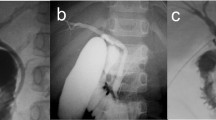Abstract
The results of surgical treatment of pancreaticobiliary maljunction at our department are described. The 67 patients who underwent surgery for this disease were divided by age into an adult group (45 patients, aged 16 years and over) and a pediatric group (22 patients, aged less than 16 years). The incidence of concomitant carcinoma before surgery and the incidence and severity of postoperative cholangitis were compared between these two groups. In addition, the cell proliferating activity of the biliary tract epithelium in cancer-free patients was compared between the two groups, using the proliferating cell nuclear antigen labeling index (PCNA LI). Ten patients (all adults) were diagnosed with cancer (gallbladder carcinoma in 7 and bile duct carcinoma in 3) before surgery. The surgical techniques used for reconstruction in the cancer-free patients were: in the adult group, hepaticoduodenostomy in 9 patients, Roux-en-Y hepaticojejunostomy in 17, jejunal interposition in 8, and another technique in 1. In the pediatric group, hepatico-duodenostomy was performed in 17 patients. Roux-en-Y hepaticojejunostomy in 3, and jejunal interposition in 2. Postoperative cholangitis occurred in 6 adults (including 2 with severe form) and 1 child (mild case). The PCNA LI of the biliary tract epithelium was high compared to control findings in the biliary tract epithelium of 10 adult patients without pancreaticobiliary maljunction. In the adult group with dilated extrahepatic bile ducts (n=10 examined) this index was 11.4% for the bile duct epithelium (control, 1.5%) and 12.7% for the gallbladder epithelium (control, 1.4%). In the adult group with non-dilated extrahepatic bile ducts (n=5 examined) it was 5.9% for the bile duct epithelium and 13.1% for the gallbladder epithelium. In the pediatric group (n=10 with extrahepatic bile duct dilatation) it was 7.5% for the bile duct and 9.7% for the gallbladder epithelium. (Differences from control values were all significant.) These results suggest that surgery for this disease should be performed as early as possible and that extrahepatic bile duct excision and biliary reconstruction should be performed whether or not extrahepatic bile ducts are dilated.
Similar content being viewed by others
References
Japanese Study Groop on Pancreaticobiliary Maljunction (JSPBM) (1994) Diagnostic criteria of pancreaticobiliary maljunction. J Hep Bil Pancr Surg 1:219–221
Tuyuguchi T, Saisho H, Yamaguchi T, Nagashima F, Ishihara T, Nagato Y, Kimura K, Saotome N, Ohto M (1993) Association of biliary tract cancer and anomalous pancreaticobiliary ductal union (in Japanese). Clin Gastoroenterol 8:1675–1681
Todani T, Watanabe Y, Toki A, Sato Y, Ogura K, Yamamoto S (1996) Surgical treatment of choledochal cysts in children. J Hep Bil Pancr Surg 3:417–422
Gigot JF, Nagoreny DM, Farnell MB, Moir C, Ilstrup D (1996) Bile duct cysts: a changing spectrum of presentation. J Hep Bil Pancr Surg 3:405–411
Joseph VT, Prema Paj J (1996) A review of choledochal cyst in pediatric and adult patients. J Hep Bil Pancr Surg 3:396–404
Hara H, Okijima K, Isozaki H, Morita S, Ishibashi T, Tanimura M, Akimoto H, Niki M, Okuda J (1994) Studies on operative procedures and postoperative cholangitis for congenital biliary dilatation—A comparison of adult and juvenile cases (in Japanese). J Jpn Soc Clin Surg 55:2776–2782
Todani T, Watanabe Y, Narisue M, Tabuchi K, Okajima K (1977) Congenital bile duct cysts: classification, operative procedure, and review of 37 cases including cancer arising from choledochal cysts. Am J Surg 134:263–269
Azuma T, Hanyu F, Nakamura M, Imaizumi Y, Yoshikawa T, Araida T, Takasaki K (1996) A clinical study on surgical treatment for anomalous arrangement of the pancreaticobiliary ductal system without dilatation of the common bile duct (in Japanese). Jpn J Gastroenterol Surg 29:806–812
Matsubara T, Sakurai Y, Sasayama Y, Hori H, Ochiai M, Funabiki T, Matsumoto K, Hirono I (1996) K-las point mutations in cancerous and non-cancerous biliary epithelium in patients with pancreaticobiliary maljunction. Cancer 77:1752–1757
Morishita H, Kamei K, Funabiki T, Marugami Y, Fukui H, Matsubara T, Futawatari H, Yamaguchi M, Hasegawa S, Arai K, Mori K, Uraguchi T, Taniguchi M, Suganuma M, Sasayama Y, Shikata A, Amano H, Ochiai M, Mizoguchi Y, Kuroda M, Imazu H, Kasahara M, Seto A, Tunomura Y, Sugiue K, Sugimoto T (1992) A case of pancreaticobiliary maljunction without bile duct dilatation associated with gallbladder cancer and minute bile duct cancer (in Japanese). Tando (J Jpn Bil Assoc) 6:176–183
Ohi R, Koike N, Matsumoto Y, Ohkohchi N, Kasai M (1985) Changes of intrahepatic bile duct dilatation after surgery for congenital dilatation of the bile duct. J Pediatr Surg 20:138–142
Author information
Authors and Affiliations
About this article
Cite this article
Hara, H., Tanigawa, N., Isozaki, H. et al. Clinical problems in the surgical treatment of pancreaticobiliary maljunction. J Hep Bil Pancr Surg 4, 453–459 (1997). https://doi.org/10.1007/BF02488981
Received:
Accepted:
Issue Date:
DOI: https://doi.org/10.1007/BF02488981




